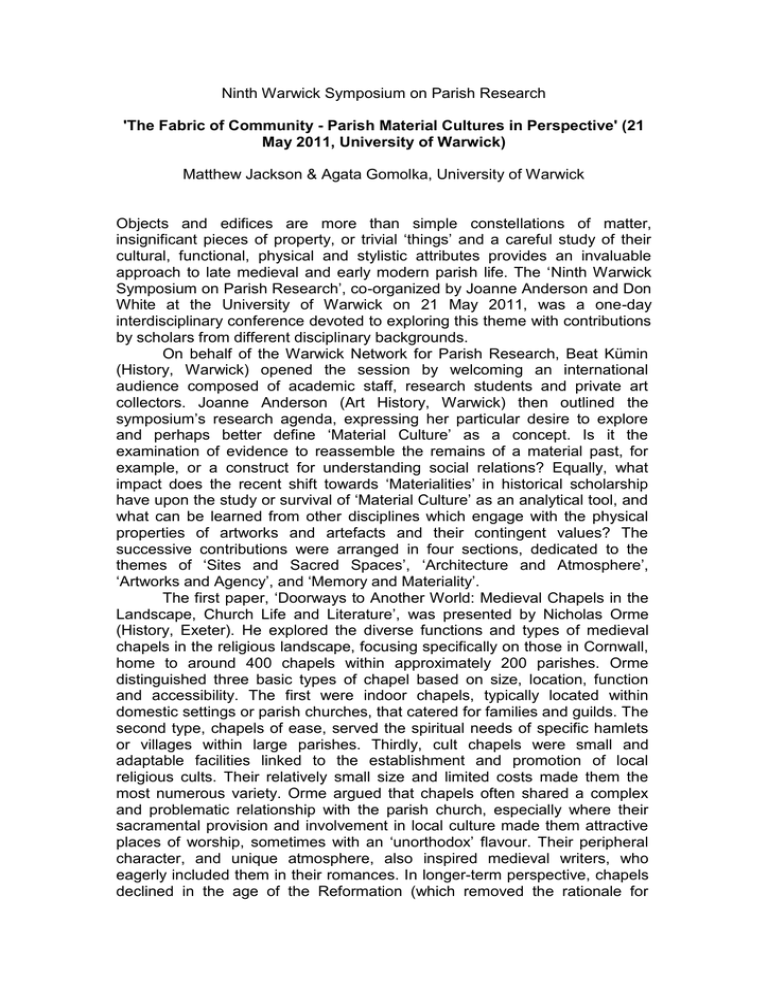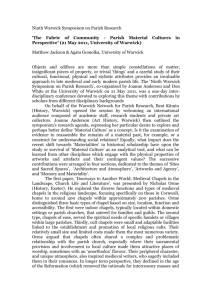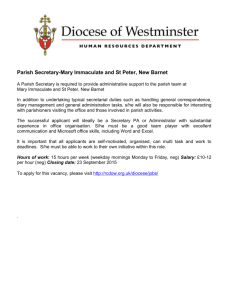Ninth Warwick Symposium on Parish Research May 2011, University of Warwick)
advertisement

Ninth Warwick Symposium on Parish Research 'The Fabric of Community - Parish Material Cultures in Perspective' (21 May 2011, University of Warwick) Matthew Jackson & Agata Gomolka, University of Warwick Objects and edifices are more than simple constellations of matter, insignificant pieces of property, or trivial ‘things’ and a careful study of their cultural, functional, physical and stylistic attributes provides an invaluable approach to late medieval and early modern parish life. The ‘Ninth Warwick Symposium on Parish Research’, co-organized by Joanne Anderson and Don White at the University of Warwick on 21 May 2011, was a one-day interdisciplinary conference devoted to exploring this theme with contributions by scholars from different disciplinary backgrounds. On behalf of the Warwick Network for Parish Research, Beat Kümin (History, Warwick) opened the session by welcoming an international audience composed of academic staff, research students and private art collectors. Joanne Anderson (Art History, Warwick) then outlined the symposium’s research agenda, expressing her particular desire to explore and perhaps better define ‘Material Culture’ as a concept. Is it the examination of evidence to reassemble the remains of a material past, for example, or a construct for understanding social relations? Equally, what impact does the recent shift towards ‘Materialities’ in historical scholarship have upon the study or survival of ‘Material Culture’ as an analytical tool, and what can be learned from other disciplines which engage with the physical properties of artworks and artefacts and their contingent values? The successive contributions were arranged in four sections, dedicated to the themes of ‘Sites and Sacred Spaces’, ‘Architecture and Atmosphere’, ‘Artworks and Agency’, and ‘Memory and Materiality’. The first paper, ‘Doorways to Another World: Medieval Chapels in the Landscape, Church Life and Literature’, was presented by Nicholas Orme (History, Exeter). He explored the diverse functions and types of medieval chapels in the religious landscape, focusing specifically on those in Cornwall, home to around 400 chapels within approximately 200 parishes. Orme distinguished three basic types of chapel based on size, location, function and accessibility. The first were indoor chapels, typically located within domestic settings or parish churches, that catered for families and guilds. The second type, chapels of ease, served the spiritual needs of specific hamlets or villages within large parishes. Thirdly, cult chapels were small and adaptable facilities linked to the establishment and promotion of local religious cults. Their relatively small size and limited costs made them the most numerous variety. Orme argued that chapels often shared a complex and problematic relationship with the parish church, especially where their sacramental provision and involvement in local culture made them attractive places of worship, sometimes with an ‘unorthodox’ flavour. Their peripheral character, and unique atmosphere, also inspired medieval writers, who eagerly included them in their romances. In longer-term perspective, chapels declined in the age of the Reformation (which removed the rationale for intercessory masses and the cult of saints), but made an indirect comeback in the nonconformist chapels of the early modern period. The paper’s discussion was largely centred on the ‘otherworldliness’ of chapels. The audience was interested in the chapel as a field for wandering thoughts (one participant describing them as ‘pockets of frozen time’ able to capture the human imagination, another likening the relationship between chapel and parish church to that of a cuckoo and the hosting nest, as chapels appeared suddenly, quickly evolved and were becoming increasingly independent and inconvenient for the parish church). Further questions explored the infinite gradation of chapels, which Orme highlighted in his paper. The use of chapels differed according to their size and location, and some provided not only a challenge to the parish church, but also aided it in handling religious celebrations and sometimes even sacraments. The presence of graveyards and the legal issues surrounding burials were additional themes that interested the audience, as was an enquiry about chapel furnishings and decorations. This line of questioning centred upon the relationships between chapel and church interiors, and how similarities and differences may have encouraged chapel users to see themselves as separate from and/or linked to nearby parish communities. Unfortunately, Orme conceded that much of this detail is now lost and historians can only speculate on the interior decoration of chapels, particularly in the case of marginal types. The discussion finished with the question of gender, and issues were raised about the segregation of women within the chapel space and the parish more generally. Kate Giles (Archaeology, York) presented the second paper on ‘Stratford-upon-Avon Guild Chapel, Warwickshire: A Medieval Guild Chapel and its Antiquarian Study’, in which she discussed findings of a collaborative research project on a complex of fifteenth-century guild buildings. Giles began by outlining the social and historical context and offered a revised view on the chronology of construction and the functions of specific sections. Erected by the Holy Cross fraternity in Stratford, the buildings did not merely serve as the guild headquarters. From the fifteenth century, almshouses and a school were added, providing additional spaces for social interaction, entertainment, care, learning and prayer. In the 1490s, the merchant Sir Hugh Clopton provided a sum of money for major renovation and decoration of the Guild Chapel. The result was an impressive fresco cycle, depicting, among other subjects, the Dance of Death and The Legend of the True Cross, subsequently whitewashed in the Reformation and rediscovered, recorded and affected by restorations in the nineteenth century. Approaching it as a unique and understudied artefact, Giles explained how a combination of stratigraphic analysis and dendrochronology with the study of antiquarian visual records allowed the production of a virtual reality model of the paintings’ stylistic and physical features. Throughout, Giles emphasised the centrality of the guild buildings to civic life and the maintenance of community spirit and well-being. The audience was fascinated by the project and asked about the technological methods used to reconstruct decorative and architectural features. Delegates agreed that computer generation provides a great resource for scholars to develop their own research, but also provides a format to connect disciplines and researchers together. The discussion then returned to the reliability of nineteenth-century antiquarian sources, which depicted contrasting fresco sequences. An interesting point was raised on the relationship between the frescos, their audience and their function. The frescos – and especially those located in the chancel – might have only been intended for a small, educated elite and perhaps there was no need for the cycle to follow the correct order of The Golden Legend as a result. Delegates also pursued the question of the chapel’s dedication, which appears as ‘Holy Trinity’ in at least one source. Continuing the focus on interior artworks, the third paper brought a geographical and chronological shift to late medieval Italy. Federico Botana (Courtauld Institute of Art) presented a paper on ‘The Case of San Nicola at San Vittore del Lazio’ which examined two fourteenth-century fresco cycles – the Seven Works of Mercy, and the Passio of St Margaret of Antioch – painted within the twelfth-century church at San Vittore, Montecassino. He began by discussing the considerable methodological challenges encountered in studying these wall paintings; first, their poor physical condition – large areas of plaster were destroyed, lost and severely discoloured – and second, the complete lack of documentation, apart from a scattering of incidental references across archival depositories. In spite of the impossibility to excavate precise dates and titles from a historical ‘cul-de-sac full of clutter’, he argued that anthropological and formal analysis could nonetheless go some way to unravelling the messages conveyed through the frescos. The depiction of hand gestures between lord and vassal, for example, indicated the meaningful ties of patronage within a medieval feudal system, while the illustration of (additional) buildings within the Seven Works of Mercy may have been intended to encourage charitable acts by townsfolk for the needy – the embodiment of intentions. In sum, he argued that a combination of diverse methodological tools (including the spatial analysis of physical surroundings) can help us to extract meaning from such a fragmentary source. The discussion began by exploring the potential and limits of anthropological and formal analysis. The shared challenges of researching the material cultures of parish life across the Continent were immediately observed. Reconstructing parish life from isolated material fragments and unidentifiable objects is a complex task, yet the audience agreed that interdisciplinary collaborative research offers the most fruitful way forward. The discussion concluded with questions on the characters depicted in the frescoes. It was suggested that the ‘lord’ may have been the abbot of Montecassino given his dress code, although the absence of a crosier from the fresco made this assumption very difficult to ascertain. Similarly, delegates speculated whether the same figure was a priest in relation to the circular scuffmarks above his head that seemingly formed a halo. The speaker responded that he had discovered no reference to this figure as a saint, and that the smudges were typical of fresco brush stroke patterns rather than a particularly significant design in this instance. Extracting meaning from parish objects therefore relies both upon the survival of the object itself, as well as comprehension of the techniques used in constructing it. Jennifer Alexander and Sofija Matich (Art History, Warwick) presented the final paper entitled ‘Creating and Recreating the Tombs to the Dukes of York in Fotheringhay Church’. They examined the complex history of two tomb monuments at Fotheringhay dedicated to Edward Duke of York (†1415), Richard Plantagenet Duke of York (†1460) and his wife Cecily (†1495). Alexander began with an introduction to the history of Fotheringhay church and the tombs. The bodies of the Yorkist dynasts were originally interred at Pontefract and moved by Edward IV to Fotheringhay in 1476. The body of Edmund Duke of Rutland, who died in battle with his Father during the Wars of the Roses, was strangely never exhumed from Pontefract and may still lie under the cottage gardens bordering the eastside of the Churchyard. The Fotheringhay tombs were damaged during the desecration of religious imagery in the 1540s and 50s, and by 1560 Elizabeth I was forced to issue a proclamation forbidding the 'breaking or defacing’ of any tomb monuments or inscriptions. It is apparently this proclamation, and Elizabeth’s alleged knowledge that her ancestors’ tombs had suffered damage, that has led scholars to attribute the renovation of the Fotheringhay tombs in 1573 to the Queen of England. Sofija Matich then provided a highly detailed crossexamination of the tombs’ heraldic decoration, material composition and sculptural techniques with similarly styled sixteenth-century monuments in Buckinghamshire and Northamptonshire. Based on this broad study of sculptural work and tomb designs, Matich challenged the assumption that Queen Elizabeth oversaw the construction of the Fotheringhay tombs. Sir Edmund Brudenell – son of a Merchant Stapler, a third-generation landowner, and commissioner of the Queen’s ancestral family burials – emerged as a more likely candidate, and perhaps completed the work with a skilled group of sculptors who were working on his house at that time. The paper’s rich findings drawn from Matich’s BA dissertation inspired a vivid discussion. Might the fact that the tomb supposedly dedicated to Richard and his wife displayed Cecily’s impaled coat of arms rather than her husband’s imply that Richard was not buried there at all? Did the lack of heraldry reflect Richard’s status as a War of the Roses’ rebel, and perhaps represent a conscious effort to avoid drawing attention to him? Delegates then focused on the parishioners of Fotheringhay and the enormous ‘culture shock’ they must have experienced in witnessing the entire Reformationrelated demolition of the east end of their church, including the choir and Lady Chapel. Alexander agreed that such a religious displacement could have upset the congregation, but they were probably pleased to see a new bridge constructed with the recovered building materials. In relation to the tombs’ evidently rushed and cheap construction, participants also questioned whether Fotheringhay’s parishioners knew that the tombs were incomplete. It was suggested that the tombs’ novelty would have made them unfamiliar to parishioners and difficult to ‘read’. The remark was contended, however, on the grounds that parishioners would have been familiar with the technical aspects of tomb sculpture even if they were unable to decipher the tombs’ specific decorative features. Even so, whether parishioners would have openly expressed disdain of work by the Queen’s commissioner is another issue. Finally, delegates explored the possibility that the tombs’ inferior composition was intentional. The 1570s and 80s in England were high times for Puritanism and the destruction of medieval parish fabrics, and thus the lack of ornate figurative decorations on the tombs may have ensured their undisturbed passing through this period. The symposium concluded with a highly productive roundtable discussion where the audience sat around physical evidence of parish material culture: a fifteenth-century oak Mary Magdalen sculpture and an early sixteenth-century oak bust of God the Father. Don White began by inviting delegates to comment on, and perhaps better delineate, the contours of the conceptual space they had all occupied in one way or another during the event: the concepts of ‘Material Culture’ and ‘Materiality’. It was suggested that ideas of ‘materiality’ range from practical considerations of material and techniques to anthropological theories of the power, agency and aesthetic value of material things. ‘Material Culture’ on the other hand was described as a way of organising social relationships involving people and material things, and the values that come about through that process. It was further suggested that ‘Material Culture’ might be understood as the way that ‘Materiality’ is deployed in particular contexts. One proposed contextual formulation was the inherent physical and sensorial properties of materials, how those materials perform and are transformed through intervention, and the effects that they may have upon people as a result. The definitions were by no means clearcut, however, and it was particularly fascinating to discover how definitions and uses of ‘Material Culture’ varied so dramatically between historians, art historians and archaeologists. For some the term ‘Materiality’ may conjure up the familiar danger of academic ‘jargon’. Others may view this usage as simply a new way of identifying considerations that have long been front and centre in art-historical and archaeological inquiry. Delegates, however, generally agreed that the concept offers a useful and theoretically broader space for scholars across disciplines to connect their varied interests in the material aspects of the past. A second conclusion was that creation of such a shared space, far from demolishing scholarly boundaries, actually reinforces the need for these differences. The plurality of material approaches on display throughout the day emphasised the diverse values of what each discipline and field has to contribute. This stressed that the way ahead is not a homogenised multi-disciplinarity, but is instead to be accomplished through the development of, and sometimes challenging interactions between, specialist knowledge and perspectives. The discussion then highlighted some potential areas for further research and some wider general comments. First, it was suggested that more research should be conducted into the phenomenology of objects, which places people’s emotional, sensory and physical experiences of objects at the centre of attention. Second, delegates emphasised how important contextual factors were for our appreciation of material objects and their cultural composites. A useful example was employed by one of the delegates describing his recent visit to Spain where he saw the alleged last remaining fragments of the True Cross. The Cross’ materiality was a piece of wood, but set within its cultural context this piece of wood represents perhaps the most important and universally recognised religious relic of Latin Christianity. The same piece of wood seen out of context, lying next to a set of train tracks for example, would have no such meaning despite being composed of the same ‘stuff’. In his concluding remarks, Beat Kümin commented upon the striking ‘multiplicity and hybridity’ of approaches used during the day’s proceedings, suggesting that spatial theory (and especially the relationship between objects, agents and atmosphere) might provide a further fruitful conceptual tool. The best evidence for this, he argued, were the two wooden sculptures placed in front of the delegates, and how their introduction to the roundtable session had helped to create a fundamentally different discussion space. In 2012, the 10th anniversary symposium on ‘Parish Studies Today’ aims to take stock of the field by highlighting the diversity of work conducted by academics, local history societies, church conservation groups and other organizations. For an open call for participation (as well as information on previous meetings) visit http://go.warwick.ac.uk/parishsymposium.





